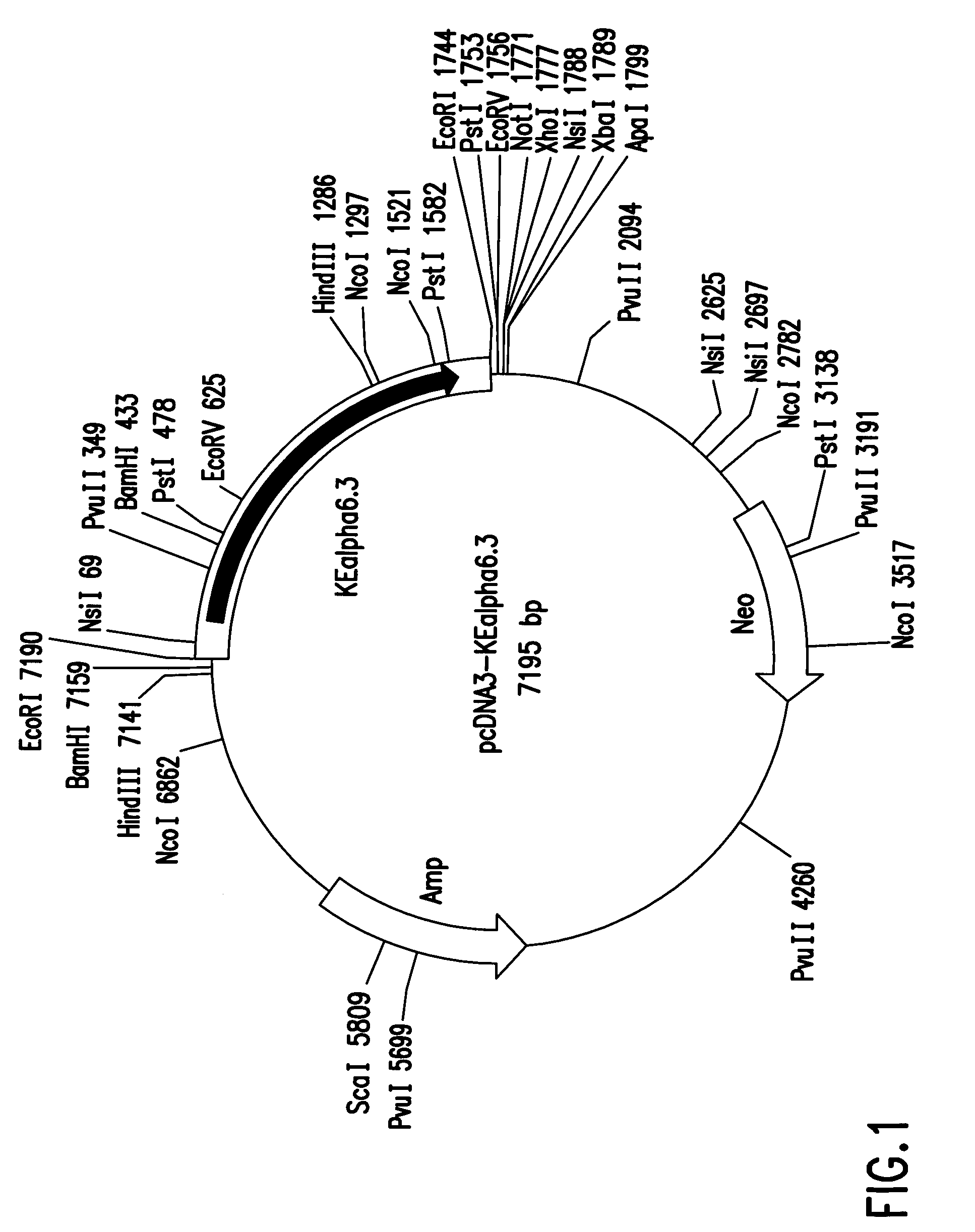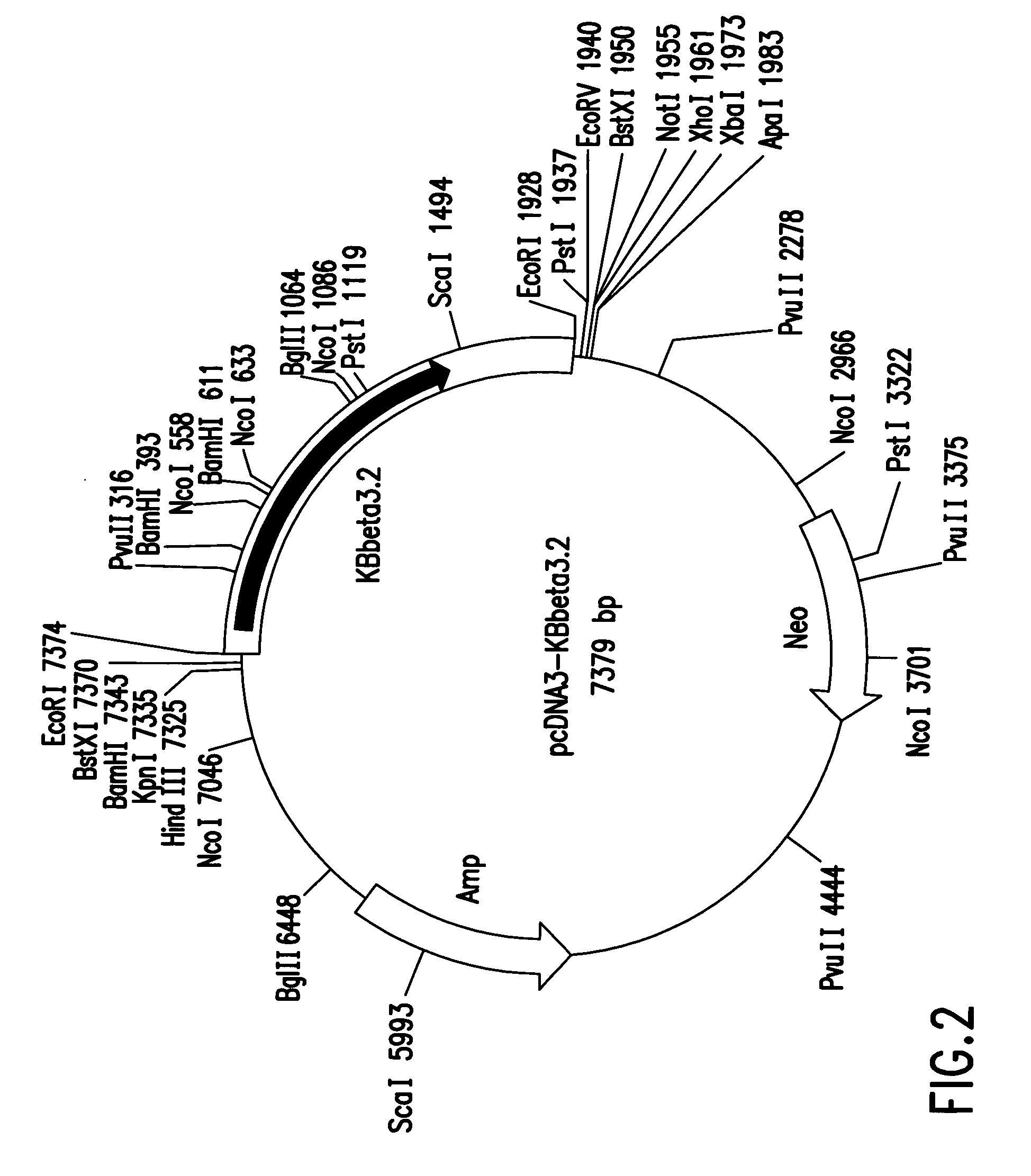Human neuronal nicotinic acetylcholine receptor alpha6 and beta3
a technology of nicotinic acetylcholine and receptor, which is applied in the direction of neuromediator receptors, peptides, tissue culture, etc., can solve the problems of incomplete understanding of how (and) the variety of receptors is arranged, and achieves the effect of fewer unwanted side effects
- Summary
- Abstract
- Description
- Claims
- Application Information
AI Technical Summary
Benefits of technology
Problems solved by technology
Method used
Image
Examples
example 1
Isolation of DNA Encoding Human nAChR α6 Subunits
[0087]A human substantia nigra cDNA library (Clontech Laboratories, Inc.) was screened for hybridization to a fragment of the rat nAChR α6 subunit cDNA. Isolated plaques were transferred to nitrocellulose filters and hybridization was performed in 5× Denhardt's, 5×SSPE, 50% formamide, 200 μg / ml denatured salmon sperm DNA and 0.2% SDS, at 42° C. Washes were performed in 0.2×SSPE, 0.2% SDS, at 60° C.
[0088]Five hybridizing clones were plaque-purified and characterized by restriction endonuclease mapping and DNA sequence analysis. The DNA sequence of the 5′- and 3′-ends of the cDNA inserts was determined using commercially available λgt10 forward and reverse oligonucleotide primers. Analysis of the DNA sequence of the five cDNA inserts revealed that three clones contained the translational initiation codon, a full-length α6 open reading frame (nucleotides 143–1624 of SEQ ID NO:1), the translational stop codon and 142 additional nucleotide...
example 2
Isolation of DNA Encoding Human Neuronal nAChR β3 Subunit
[0094]A human substantia nigra cDNA library (Clontech Laboratories, Inc.) was screened for hybridization to synthetic oligonucleotide primers complementary to the C-terminus of human nicotinic nAChR β3 subunit cDNA. Isolated plaques were transferred to nitrocellulose filters and hybridized under high stringency conditions with respect to oligonucleotides (washing conditions 1×SSPE, 0.2% SDS at 50° C.) with synthetic oligonucleotide primers complementary to the partial human β3 nAChR subunit described by Willoughby et al., (1993) Neurosci. Lett. 155, 136–139.
[0095]Two hybridizing clones were plaque-purified and characterized by restriction endonuclease mapping. The DNA sequence of the 5′- and 3′-ends of the cDNA insert was determined using commercially available T7 and SP6 oligonucleotide primers. The complete sequence of clone KBβ3.2 was determined. Clone KBβ3.2 contains a 1927 bp cDNA insert that contains a 1,377 nucleotide o...
example 3
Preparation of Constructs for the Expression of Recombinant Human Neuronal nAChR Subunits
[0099]Isolated cDNAs encoding human neuronal nAChR subunits were incorporated into vectors for use in expressing the subunits in mammalian host cells and for use in generating in vitro transcripts from the DNAs to be expressed in Xenopus oöcytes. The following vectors were utilized in preparing the constructs.
A. Constructs for Expressing Human nAChR α6 Subunits
[0100]A 1,743 bp EcoRI fragment, encoding a full-length ACh α6 subunit, was isolated from KEα6.3 by standard methods and ligated into the EcoRI polylinker site of the vector pcDNA3 to generate pcDNA3-KEα6.3 (see FIG. 1). Plasmid pcDNA3 (see FIG. 1) is a pUC19-based vector that contains a CMV promoter / enhancer, a T7 bacteriophage RNA polymerase promoter positioned downstream of the CMV promoter / enhancer, a bovine growth hormone (BGH) polyadenylation signal downstream of the T7 promoter, and a polylinker between the T7 promoter and the BGH p...
PUM
| Property | Measurement | Unit |
|---|---|---|
| mass | aaaaa | aaaaa |
| pH | aaaaa | aaaaa |
| voltage- | aaaaa | aaaaa |
Abstract
Description
Claims
Application Information
 Login to View More
Login to View More - R&D
- Intellectual Property
- Life Sciences
- Materials
- Tech Scout
- Unparalleled Data Quality
- Higher Quality Content
- 60% Fewer Hallucinations
Browse by: Latest US Patents, China's latest patents, Technical Efficacy Thesaurus, Application Domain, Technology Topic, Popular Technical Reports.
© 2025 PatSnap. All rights reserved.Legal|Privacy policy|Modern Slavery Act Transparency Statement|Sitemap|About US| Contact US: help@patsnap.com


